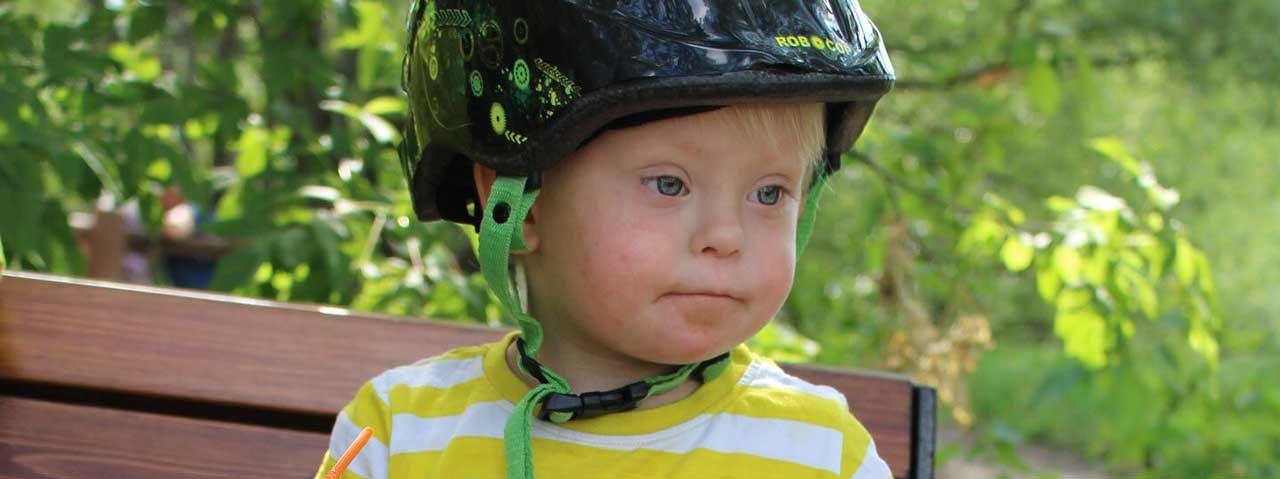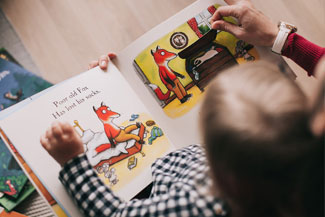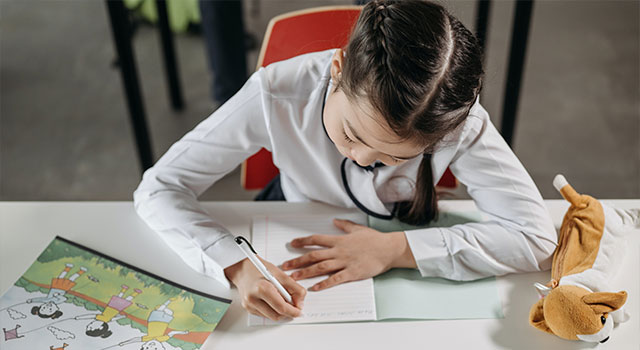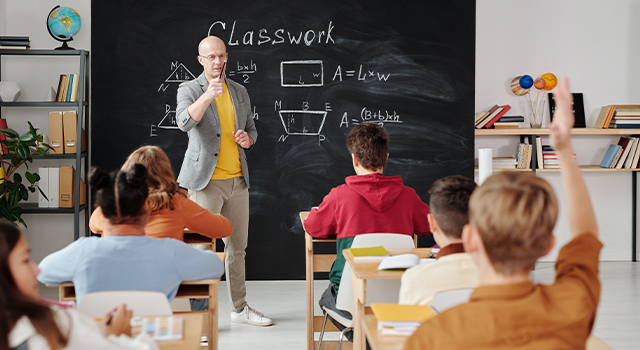
Down Syndrome and Vision
Down syndrome (DS) is a genetic disorder caused by a duplication of all or part of chromosome 21, making three copies of the chromosome rather than the usual two. This extra chromosome causes certain intellectual, developmental and physical changes in persons with Down syndrome.
The frequency of Down syndrome is approximately 1 in every 800 births, making it one of the most common chromosomal abnormalities. Thanks to improved medical care, people with Down syndrome are leading longer and healthier lives.
More than 60% of children with Down syndrome (DS) have vision problems, according to the National Institute of Child Health and Human Development. Most need to wear eyeglasses. Often, their optical prescriptions are in the higher range, meaning that specific frames and lenses are required.
It is important to note that people with Down syndrome are more likely to have a range of problems with their eyesight, so even if they wear glasses, they may not achieve 20/20 vision, which is considered the standard of perfect sight.
Eye Exams in Those With Down Syndrome
Down syndrome can affect the eyes’ development, which in turn affects vision. More than 50% of people with Down syndrome have some sort of eye disease ranging from minor tear duct abnormalities to vision-threatening early-onset cataracts.
Children and adults with DS should have regular eye checks. The UK Down Syndrome Medical Interest Group suggests the following basic minimum eye checks for babies and children with Down syndrome:
- Birth to 6 weeks – Newborn routine examination including a congenital cataract check
- Age 18 to 24 months – Formal eye and vision examination including a check for eye turns, myopia (nearsightedness) and hyperopia (farsightedness)
- Age 4 years – Formal eye and vision examination including check for squint, as well as an assessment for myopia, hyperopia and visual acuity
- School age – Repeat vision test every 2 years, or more frequently if recommended by optometrist or ophthalmologist
- Teenagers and adults should have a full assessment by an optometrist or ophthalmologist at least every 2 years or more frequently as advised.
Down Syndrome and Eyeglasses
Because individuals with Down syndrome usually have small noses, shortened depth from the eye socket to the ear and close-set eyes with wide faces, typical glasses slide down, fall forward and bow out at the temples.
For these reasons and others, it’s difficult for them to find frames that fit.
There are now a range of optical frames designed for people with DS that allow the bridge to be adjusted. The temples are modified to keep the glasses from constantly slipping.
Optical lenses often used for DS patients include transition, high index and bifocal designs.
Accommodation (focusing) is reduced in approximately 75% of children with Down syndrome. Bifocals have been shown to be beneficial for these children, and they are prescribed regularly.
Down Syndrome and Vision Problems
Individuals with Down syndrome are at increased risk for a variety of eye and vision disorders. Fortunately, many of these eye problems can be treated, especially if discovered at an early age. Their quality of life can be further enhanced by the proper assessment and correction of eye problems. The most common eye findings include:
- Refractive errors – Children with Down syndrome are more likely to need glasses than other children. This may be due to myopia, hyperopia and/or astigmatism. Refractive error may develop early in life or later on.
- Strabismus and Amblyopia – Between 20% and 60% of individuals with Down syndrome have a lazy eye (amblyopia) or eyes that are misaligned (strabismus). Esotropia (eyes that drift in) is most common, while exotropia (eyes that drift out) occurs less frequently. Amblyopia and strabismus may be treated with glasses, patching, vision therapy and/or eye muscle surgery.
- Keratoconus – A cone-shaped distortion of the cornea (front layer of the eye), occurs in up to 30% of those with Down syndrome. Keratoconus is usually diagnosed around puberty and should be monitored regularly. Blurred vision, corneal thinning, or corneal haze may result from keratoconus. Keratoconus is worsened by eye rubbing; therefore, eye rubbing should be discouraged and its causes (allergies, dry eye) treated.
- Cataracts – There is an increased incidence of congenital cataracts (present at birth) as well as acquired cataracts. The cataracts may progress slowly and should be monitored regularly, with surgical treatment performed when appropriate.
- Glaucoma- There is an increased risk of infantile glaucoma, elevated pressure within the eye.
- Blepharitis – Inflammation of the eyelids with redness at the edge of the lids and crusting around the lashes may occur and cause a feeling of dryness or burning. This is managed well with topical steroids and antibiotics.
- Tearing – Excessive tears or watering of the eyes may occur because the drainage channels are blocked or narrow (nasolacrimal duct obstruction). This may require surgical intervention.
- Nystagmus – This is an involuntary “back-and-forth” movement or shaking of the eyes. It can affect vision to a mild or severe degree.
Down Syndrome and Strabismus
Strabismus (eye misalignment) is also more common in DS than in the general population. Family members may notice that the eyes do not line up well with each other, but often the strabismus is subtle. The folds of skin between the eyes and the nose can also cover up the underlying strabismus, or make the eyes appear as if they are crossing even if they are not. It is important to diagnose strabismus in a child, as crossed eyes can lead to amblyopia (also known as lazy eye) and loss of stereopsis (3D vision) or depth perception.
Sometimes, glasses alone are enough to straighten eyes with strabismus. If the eyes continue to be misaligned, despite the correct pair of eyeglasses, then vision therapy or even eye muscle surgery may be required. In the event eye surgery is required, patients with Down syndrome are more likely to require more than one surgery to align their eyes, as they don’t always respond as predictably to strabismus surgery as the general population.
Down Syndrome and Cataracts
Cataracts are a clouding of the lens inside the eye. If cataracts are present from a very young age, a clear image is not delivered to the child’s brain, so unless the cataracts are surgically removed, the brain will never “learn” to see properly. This can cause a severe form of amblyopia known as deprivational amblyopia.
Cataracts that are present very early in a child’s life can result in lifelong poor vision. For this reason, early detection and surgery are essential.
 Signs of Vision Problems
Signs of Vision Problems
Unfortunately, children with Down Syndrome often do not complain about their eye problems, either because they don’t notice the problem or because they have difficulty communicating what is wrong.
Signs of vision problems can include:
- Squinting
- Closing one eye shut
- Unusual head tilt
- Crossing or wandering of one or both eyes
- Light sensitivity
- Ptosis (eyelid droop)
- Tearing or discharge (blocked tear duct)
In some severe cases, regression in overall function or loss of developmental milestones may be a sign of vision problems.
For children with Down syndrome, regular eye exams by an eye doctor are especially important because eye disorders are so common and are often difficult for a pediatrician to diagnose. Because the examination can be difficult for both the child and the doctor, it is best to have the examination done by an eye doctor skilled in dealing with children with developmental delays.
Vision Therapy for Down Syndrome
Vision therapy is often recommended for Down syndrome as there is a high incidence of functional vision difficulties as well as amblyopia (lazy eye) and strabismus (eye turn).
Eye doctors can offer a fully personalized vision therapy program designed to enhance the child’s visual skills by incorporating tasks that are appropriate to the child’s level of ability.
Vision therapy sessions will enhance the following visual skills:
- Eye alignment
- Eye teaming
- Eye focusing
- Eye movements
- Visual processing
Don’t be surprised to find out your child needs glasses; glasses will help their vision, and possibly their eye alignment, as well as the development of normal vision pathways in the brain. This will help with your child’s learning and functioning.
Vision is our dominant or primary sense, and optometric vision therapy is a leading form of sensory integration therapy. The resulting improvements in visual developmental skills can have a significant impact on many other behaviors and/or developmental or life skills that might enhance your child’s overall functioning and quality of life.
Contact Dr. Denise Smith at The Center for Vision Development who will evaluate your child’s vision and will provide a customized vision therapy program suited to his or her unique needs.
Our practice serves patients from Austin, Waco, Round Rock, and Buda/Kyle, Texas and surrounding communities.









